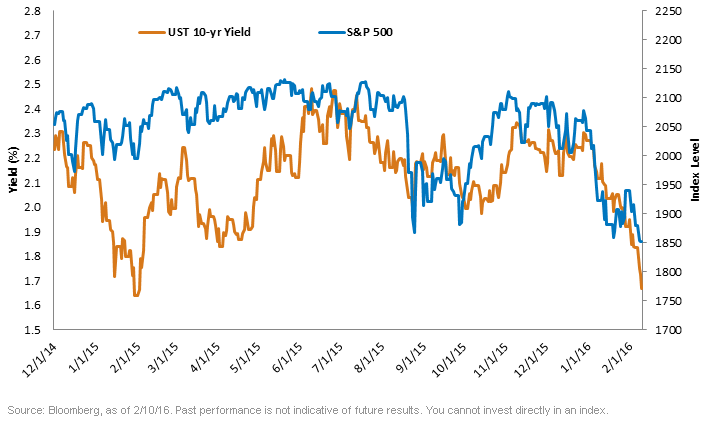U.S. 10 Year Treasury Yields: “Groundhog Day: The Sequel”


 Certainly one potential market-moving event, Federal Reserve (Fed) Chairman Janet Yellen’s semiannual monetary policy testimony before Congress, apparently did not alter investor sentiment as yet. Given the volatile nature of the global financial markets in recent weeks, that was probably her intention. Yellen seemed to walk the fine line between acknowledging recent events and not igniting any further anxieties. The relatively balanced testimony highlighted the risks of foreign economic developments to U.S. growth and less supportive financial conditions, such as equity declines, wider credit spreads and a stronger U.S. dollar, but also mentioned how job gains and improved wages should provide a lift to income, consumer spending and the domestic economy in general. There is no doubt the Fed will be “monitoring global economic and financial developments” very closely, and at this point, unless there is a sea change in the aforementioned headwinds, the FOMC looks to be on hold.
As we have seen in a variety of financial instruments, the UST 10-Year also seems to have discounted a lot of negative news. Based on recent behavior over the last month, further declines in equities will most likely continue to put downward pressure on Treasury yields. However, barring a crisis situation, we believe fixed income investors may want to avoid chasing the current rally, and if the equity arena were to stabilize, Treasuries would lose a key supporting influence. Even in a range-bound landscape, the UST 10-Year yield can reverse course quickly. Looking at last year as an example, after posting the aforementioned low, the 10-Year yield hit a high of 2.48% not five months later.
Certainly one potential market-moving event, Federal Reserve (Fed) Chairman Janet Yellen’s semiannual monetary policy testimony before Congress, apparently did not alter investor sentiment as yet. Given the volatile nature of the global financial markets in recent weeks, that was probably her intention. Yellen seemed to walk the fine line between acknowledging recent events and not igniting any further anxieties. The relatively balanced testimony highlighted the risks of foreign economic developments to U.S. growth and less supportive financial conditions, such as equity declines, wider credit spreads and a stronger U.S. dollar, but also mentioned how job gains and improved wages should provide a lift to income, consumer spending and the domestic economy in general. There is no doubt the Fed will be “monitoring global economic and financial developments” very closely, and at this point, unless there is a sea change in the aforementioned headwinds, the FOMC looks to be on hold.
As we have seen in a variety of financial instruments, the UST 10-Year also seems to have discounted a lot of negative news. Based on recent behavior over the last month, further declines in equities will most likely continue to put downward pressure on Treasury yields. However, barring a crisis situation, we believe fixed income investors may want to avoid chasing the current rally, and if the equity arena were to stabilize, Treasuries would lose a key supporting influence. Even in a range-bound landscape, the UST 10-Year yield can reverse course quickly. Looking at last year as an example, after posting the aforementioned low, the 10-Year yield hit a high of 2.48% not five months later.
Important Risks Related to this Article
Fixed income investments are subject to interest rate risk; their value will normally decline as interest rates rise. In addition, when interest rates fall, income may decline. Fixed income investments are also subject to credit risk, the risk that the issuer of a bond will fail to pay interest and principal in a timely manner or that negative perceptions of the issuer’s ability to make such payments will cause the price of that bond to decline.


